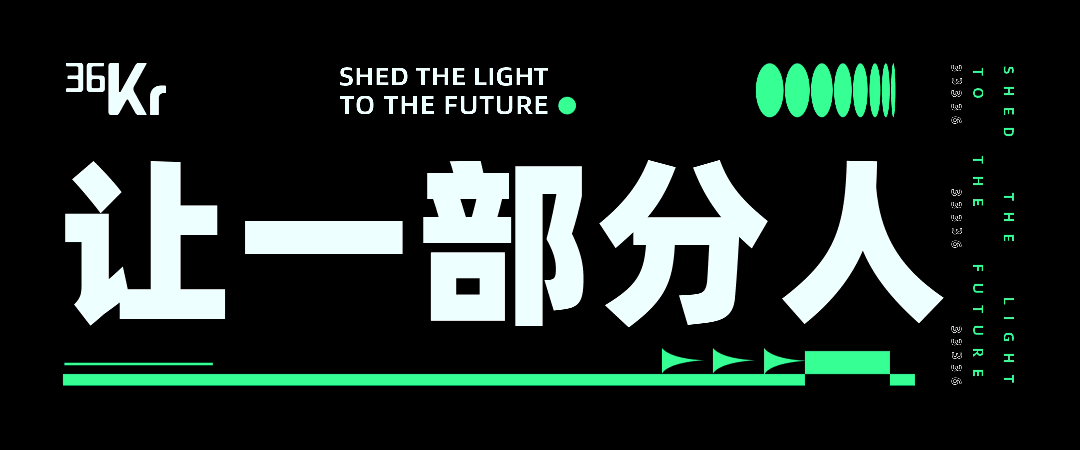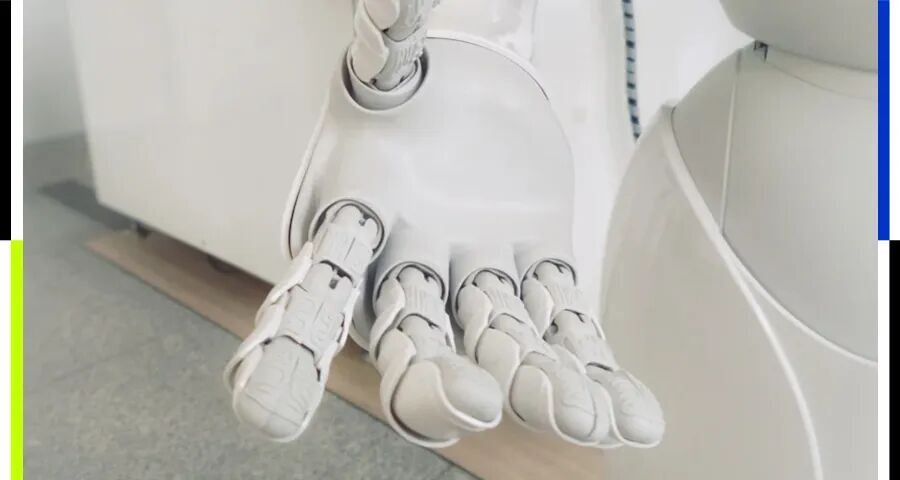

This AI-powered massage experience has lost its essential meaning of relaxation.

 Written by| Xiao YaoEdited by| Yuan YeSource|略大参考(ID:hyzibenlun)Cover Source|Unsplash
Written by| Xiao YaoEdited by| Yuan YeSource|略大参考(ID:hyzibenlun)Cover Source|Unsplash
Misplaced Priorities
For any emerging technology, entering the consumer market is a significant milestone. Just like the green fruit hanging on a tree, it signifies that it is one step closer to maturity.
So, when I searched for shoulder and neck massages on a local living platform and found “AI Robot Massage” near my company, I wasn’t too surprised. With robots already appearing in various applications, it seems normal to see them in more scenarios.
What’s rare is that it is not expensive. A 45-minute session, with options for shoulder, waist, and abdomen, originally priced at 499 yuan, costs less than 60 yuan after discounts.
According to my appointment time, I arrived at the massage shop. The entrance was not easy to find, located between a commercial area and a residential area in Beijing’s East Third Ring Road, without a storefront, just a unit in a row of identical high-rise buildings with a sign.
Upon entering, the sci-fi movie-inspired clean, quiet, and tech-filled AI filter was instantly shattered. I was welcomed by a “living room” filled with beds and 4-5 elderly people chatting animatedly while sitting or lying on them. After I walked in, two people in black uniforms called me “sister” and surrounded me. All these elements made me feel like I was visiting relatives during the New Year.
I was quickly led into a room with a bed and a white machine—this was the AI massage robot advertised, but I preferred to call it a mechanical arm with a base.
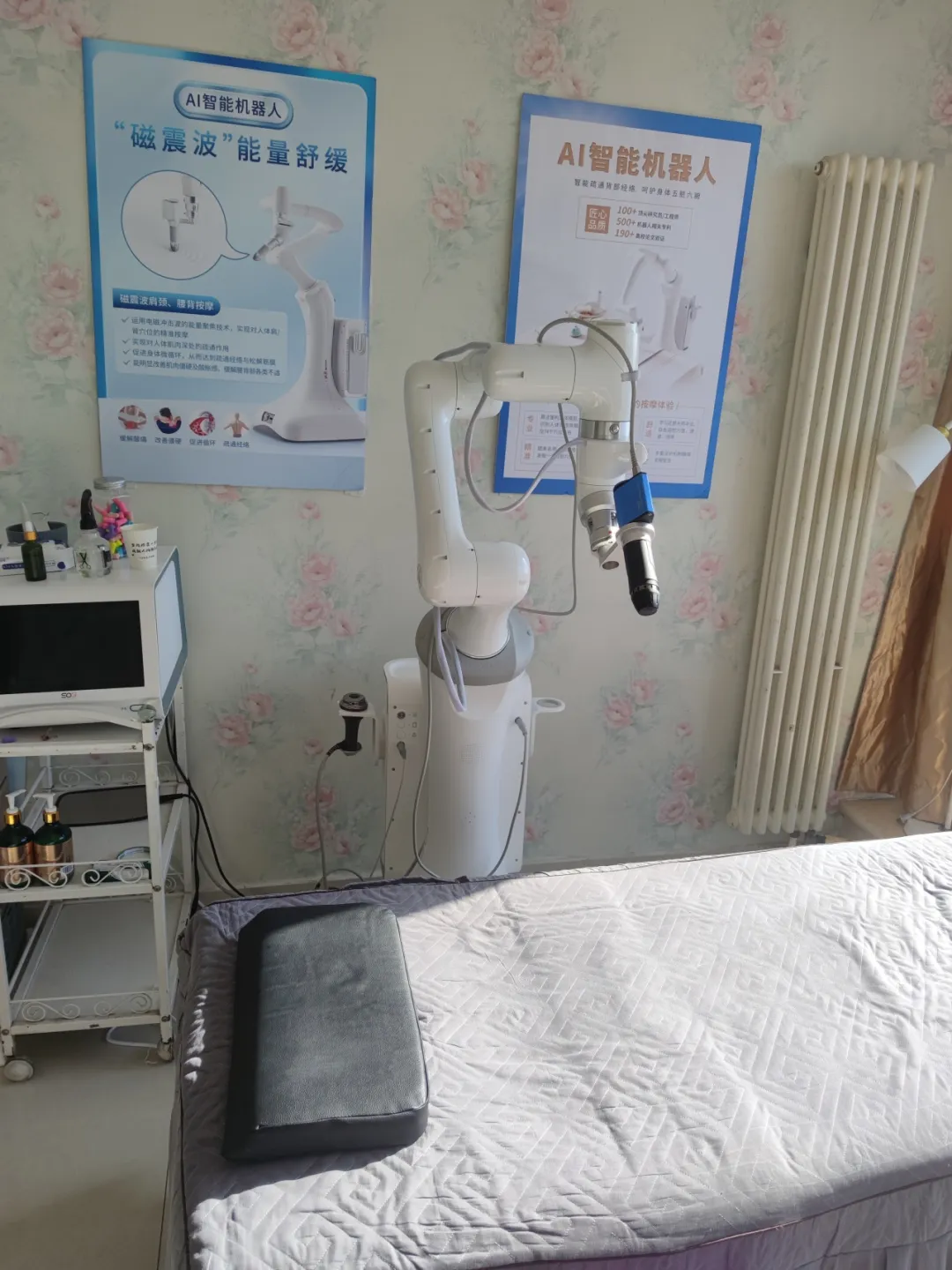
Image Source: Provided by the author
However, starting it did not seem easy. The staff took 20 minutes to successfully scan the code. At one point, she even suggested switching to a manual massage of the same price. This made me doubt the previous answer I received when I inquired if this robot massage was popular, which was “there are people using it every day.”
Following the staff’s instructions, I took off my top and placed my stomach on a metal pad, and the massage began.
The first “back-opening” phase was performed by a human, applying essential oil and providing initial relaxation. The robot then took over, using a heated probe to press against my back skin back and forth. It was evident that due to the smooth shape of the probe, it could not perform basic massage actions like kneading. Although it continuously played sounds of flowing water and guqin music, the more prominent presence was the buzzing sound produced by the mechanical movements.
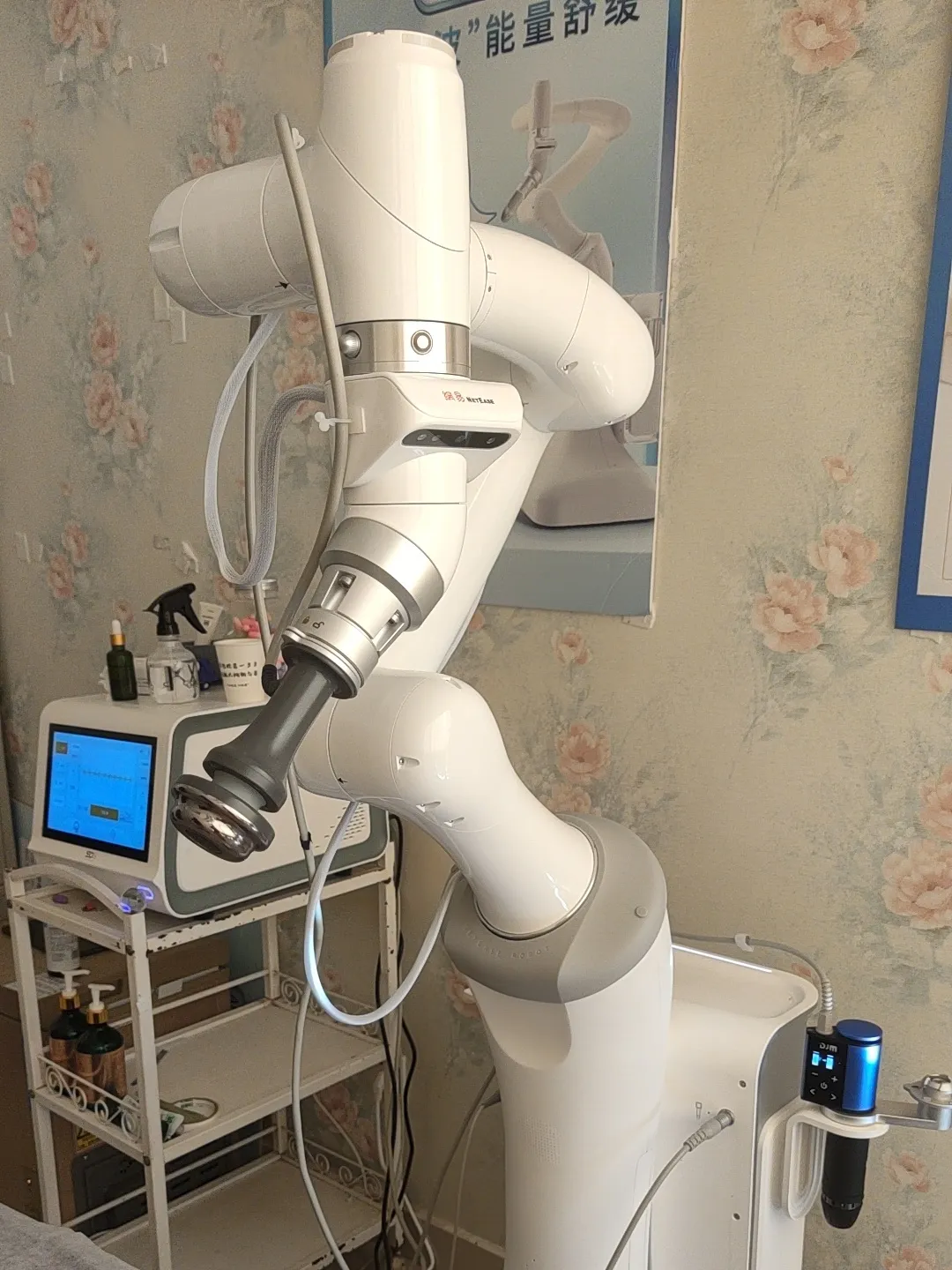
Image Source: Provided by the author
The robot also reminded us that we could control its temperature and intensity by voice. During this time, the staff kept coordinating with the robot’s rhythm, replenishing essential oil on my back every few minutes and telling me to speak up if I felt any discomfort.
However, my tension did not ease. In this supposed to be a highly relaxing wellness project, I was either worried: if the robot’s intensity adjustment malfunctioned and it applied too much force, would I be paralyzed? Or I was conflicted: if I reduced the intensity, would the massage be ineffective?
Before I could make a decision, I began to feel a stabbing pain in my abdomen due to heightened mental tension. In the latter half, I experienced increasing discomfort, such as a chill in my back. I guessed this might be because the robot itself had no temperature; even though the probe was warm, its limited area meant that parts not “swept” by it were left exposed.
After 45 minutes, the staff helped me wipe off the essential oil from my back and handed me my clothes.
“You must have fallen asleep just now,” she probably wanted to demonstrate that the “very comfortable” promise made to me was indeed true. However, I could not give a definite answer: in fact, I not only did not feel relaxed and enjoyed during the massage, but also did not care to check if my cervical spine issues had improved afterward; I only felt a sense of relief at having escaped a disaster.
In my view, this AI-powered massage has lost its essential meaning of relaxation.
Before leaving, I asked the staff if elderly customers in the shop usually used the robot massage. She replied that the use of the robot was subject to certain restrictions, and those with heart problems could not use it.
It seems more like a traffic product designed to attract young consumers.

Transformation
After completing the consumption, the platform recommended several projects using robots for body services, including not only massages but also hair washing, moxibustion, stretching, and meridian clearing.
I am certain I will not try any of them again because they share a common point: the robot touches the more vulnerable parts of the human body—head, waist, abdomen, spine, and there are already comments in the review section about hair getting tangled with the robot during hair washing, which I clearly do not want to pay to experience again.
In contrast, the efforts of the massage shop staff seem more reliable:AI is just a tool; she is more interested in converting me into a regular customer of the shop.
Let’s turn the clock back to that afternoon.
After I got up from the bed, she asked me, “Do you live nearby?”
After receiving an affirmative answer, she recommended a package originally priced over 2000 yuan, now priced at 999 yuan, and offered a free trial of the equipment, one for body checks and another for leg maintenance.
I tried to inquire about the machine’s operating principles but only received vague answers and the repeated phrase “very good for the body.” The trial session was arranged in another room, and the testing equipment looked like two computers pieced together, with a middle-aged man in a white coat operating one side. I needed to remove metal objects, take off my shoes and socks, place my hands and feet on designated four metal areas, and report my name, phone number, age, height, and weight to start the check-up.
The entire process took only 3 minutes. After waiting for 5 minutes, my test results were already out.
This was an impressive report, interpreting my physical condition from both traditional Chinese medicine and Western medicine perspectives, covering multiple organs and systems, and it was quite comprehensive. The man in the white coat explained it; he spoke at length about the traditional Chinese medicine part, while the Western medicine part was clearly glossed over, more like a buy-one-get-one-free deal on a bottle of yogurt nearing its expiration date.
During this, he also seemingly recreated a classic scene from the show “Ma Dashuai” with his “inquisitive teaching” style:
When I saw that one of my lung indicators was far below the normal value and asked why, he countered, “What do you think it is due to?” Upon hearing my answer, “Maybe due to the impact of the pandemic,” he expressed agreement.
The end of that report contained health advice. In addition to the usual recommendations of a light diet, not staying up late, and moderate exercise, it specifically mentioned taking health supplements and getting massages. Coupled with this, the man in the white coat emphasized the equipment, claiming it checks the body by activating living cells, which previously only astronauts could use.
The second trial project was leg maintenance, which was quite simple: I just needed to sit in a chair and place my calves into the device.
Once the device started, the staff played two videos explaining the device’s principles on her phone, which answered my previous questions, and then she awkwardly recited the introduction. I kept cooperating with her, feeling like a teacher conducting encouraging teaching.
After 30 minutes, the trial ended, and she asked if I wanted to purchase this package. Since both devices felt like a tax on intelligence—the so-called leg maintenance was merely infrared heating—I politely declined.
She then suggested I try the shop’s popular project: negative ions for improving sleep. Out of curiosity, I accepted again. It turned out that the popular ones indeed have their reasons; this was the most effective among the four devices, lying flat on the bed, feeling the airflow and electric current flowing from my face and upper body, the tingling sensation was indeed very hypnotic.
At this point, I had almost experienced all the devices in sight, and I had driven away three waves of customers from the shop.
Throughout the experience, I could always hear the voices of other staff chatting with customers, and based on these conversations, I could infer that the main customers in the shop are elderly people, who come every day and are very familiar with each staff member. The latter not only knows their physical conditions and daily activities well but also understands their families and mahjong partners, allowing them to greet them accordingly.
This reminded me of previous news reports about wellness centers using emotional selling to get retired elderly people to buy tens of thousands of yuan worth of wellness beds. Indeed, the underlying logic of sales is always human nature.
In the face of sales that are proficient in human nature, algorithms sometimes seem overly foolish.
After finishing this experience, the platform immediately recommended a similar package—998 yuan for 15 sessions of a Harbin Institute of Technology robot that can regulate blood pressure and blood sugar, 20 bottles of glacial water, and 17 days’ worth of blood pressure medication. This made me start to think about what my profile on the platform had become.

Hot Topics
Two industries that “dominate” the elderly: wellness and short videos, miraculously share a common point: actively embracing trends.
In terms of acceptance of robots, the elderly seem to be more open than I, a post-00s individual. Take the robot massage project that I certainly will not repurchase; it has already flourished in the wellness industry.
Searching for “robot massage” on mainstream local living platforms, you will find that from major chain wellness institutions to individually operated massage shops, all have launched AI-related projects, some even applying reasoning large models, and these projects rank very high in sales within the shops.
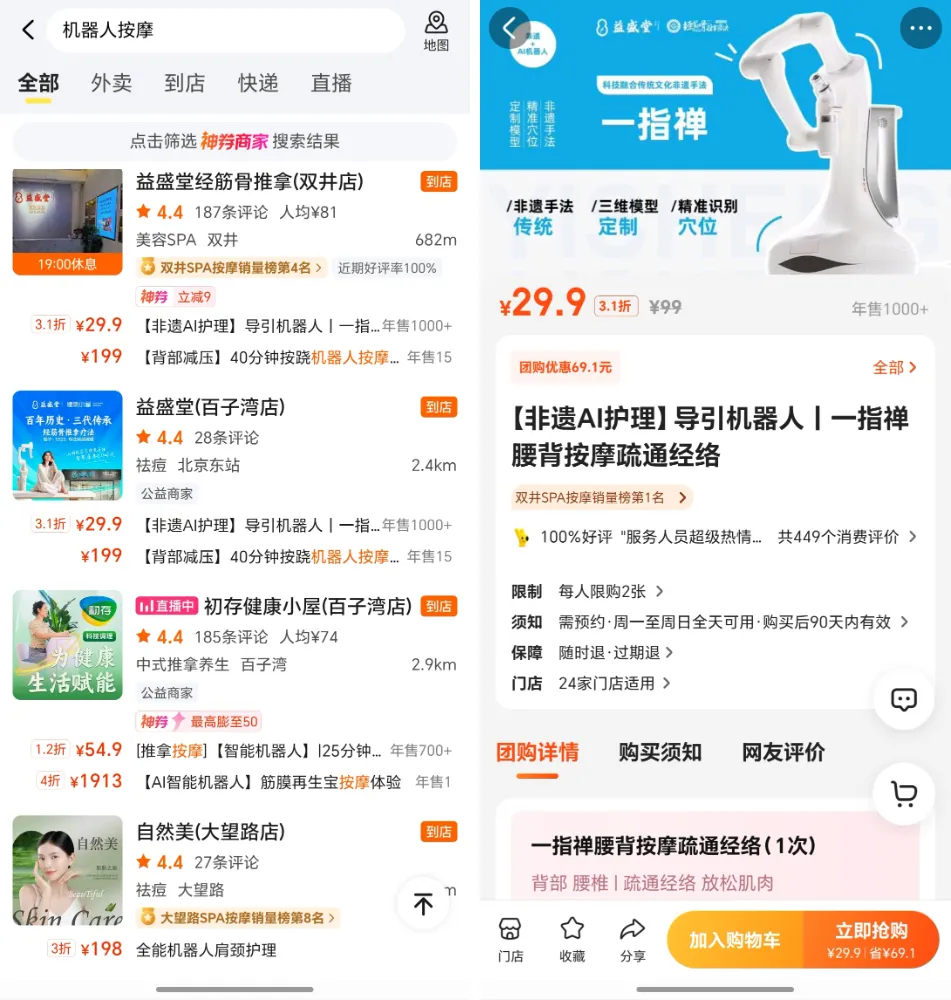
Correspondingly, the therapeutic robot sector is very hot: companies like Aobo Intelligent, internet companies like NetEase, and medical technology companies like Deyi Medical have all launched therapeutic robot products in the past two years, with several companies’ related products expected to reach thousands of units in shipments by 2024. The chain wellness brand “Xiuyuan” signed a three-year order for 10,000 therapeutic robots with Aobo Intelligent in 2022. For reference, currently, the market retail price for an moxibustion robot is below 50,000 yuan, while the retail price for a massage robot ranges from 100,000 to 150,000 yuan.
According to Frost & Sullivan data, from 2023 to 2026, the market size of rehabilitation robots in China will grow from 2.04 billion yuan to 7.95 billion yuan, with an expected annual compound growth rate of 57.5%.
Although AI robots did not play a positive role in my experience, from the perspective of industry development, technology represented by AI is becoming a lever for many companies to transform and upgrade.
Because it can bring higher industrial added value.
On one hand, manual techniques and skills are relatively simple and fixed, making it difficult for service prices to rise significantly, while the rapid development and high premium characteristics of technology can well compensate for this; if the equipment comes from well-known universities, research institutions, or large companies, the price increase effect is even better; on the other hand, applying technology is more conducive to forming service differentiation, bringing competitiveness.
According to the “2024 Massage and Foot Therapy Industry White Paper” released by iResearch, the market size of the massage and foot therapy industry has grown for three consecutive years, and it is expected to reach 700 billion yuan by 2025, with a sharp increase in the number of merchants. Meanwhile, the top 10 brands’ order share has remained around 8.5%, and their average transaction price has dropped from around 400 yuan to less than 300 yuan due to factors like consumption downgrade and intensified competition, indicating that the industry has not formed a strong brand effect.
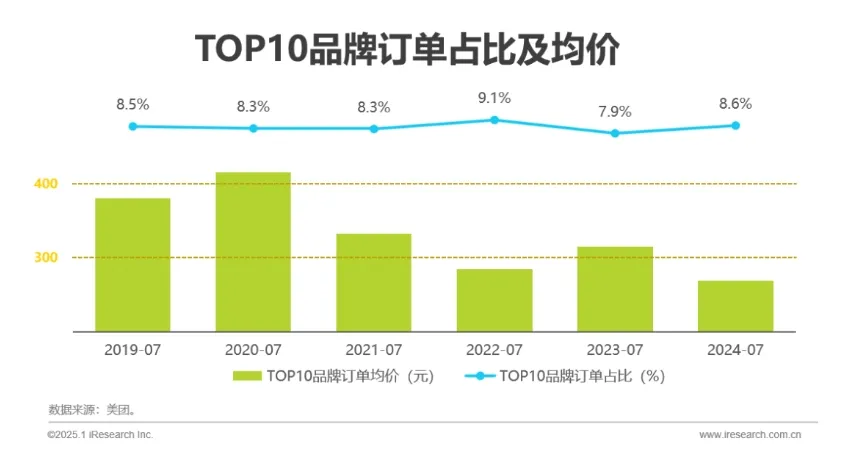
Image: “2024 Massage and Foot Therapy Industry White Paper”
In recent years, several larger chain brands in the industry have been transforming towards technology. Brands like Xiuyuan, Yishengtang, and Liu Jun Health have all made efforts in digitalization and intelligence to varying degrees. Among them, Xiuyuan has launched two AI therapeutic robots in collaboration with a research team from Beihang University, while Liu Jun Health has partnered with the Shenzhen Green Star Interstellar Space Technology Research Institute to develop the “Mosuikang” series of aerospace health equipment targeting sub-health conditioning for middle-aged and elderly people.
As for whether these products have promotional effects and their effectiveness, there is still controversy. Many consumers question whether the qualifications and promotions of these AI devices are exaggerated, and some have gone to the hospital for checks after receiving treatments, only to find no improvement in their physical conditions. After all, similar tricks are emerging one after another. A report aired by CCTV in October 2024 revealed that the so-called energy cabin, which claims to treat diseases and promote health by simply lying down and turning on the power, is actually just a sauna cabin, and the related technology health management centers mainly use it to attract customers and develop franchisees. Nowadays, some brands merely change the keywords from the vague “energy” to the trendier AI.
In any case, the tricks are the same: emphasizing that sincerity leads to effectiveness, and belief brings results, while disbelief leads to nothing.




